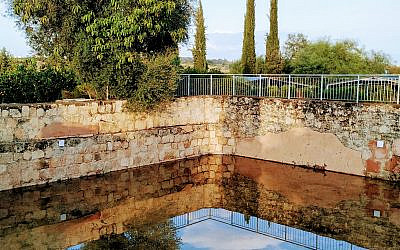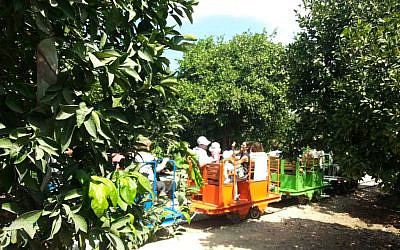אין מוצרים בסל הקניות.
THE BLOGS - Tania Shalom Michaelian
Birth of Water Innovation in the Start Up Nation
פורסם: 26.3.2023
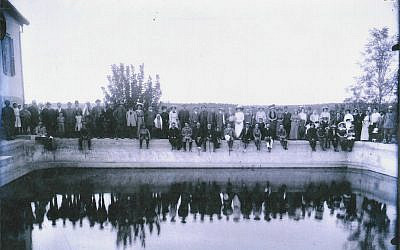
Residents of early Rehovot posing next to the pool at Minkoff Orchards, 1913
Zalman Minkoff dreamed of growing oranges in the Land of Israel at the start of the 20th century. Little did he know just how much his method of irrigating his orchards would change the face of agriculture, contribute to the national economy and turn Israel into a world-leader in water innovation
One of the many things that the Start-Up Nation is known for is its innovation in water. As a country that is more than half-desert, we’re in the incredible position today of producing 20% more water than we need. Finding a solution to the country’s water problem got many great minds thinking over 100 years ago. Even Theodor Herzl devised a revolutionary plan to transport water for great distances in his utopian novel Altneuland [The Old New Land], written in 1902
When early agriculturalists in Eretz Israel looked at growing produce from the land in the late 19th and early 20th centuries, the greatest problem they faced was water shortage. Even at times when their lands were located near a fresh water source, the main problem was transporting the water to the trees and plants
When Zalman Minkoff, a young, well-educated entrepreneur and man of the First Aliyah, purchased 25 acres of land in Rehovot in 1904, his dream was to plant the very first citrus orchard in the country. Like many agricultural ventures of the day, the Minkoff Orchard was built within the stone walls of a “biara” (Arabic for ‘well house’). The area comprised a packing house for the fruit, storage rooms, stables, a dining room for the workers and a room for the guard, alongside the trees
The orchard’s soil was good, but the water lay buried deep underground. Minkoff’s first step was to design a well that would not only provide the right amount of water for the orchard and the people working and living in the biara, but also to minimize waste and maximize efficacy. The well took ten months to build and by the time it was complete, it was 72 feet deep (the height of a 7-story building) and almost 20 feet in diameter
The pioneering Minkoff then installed a mechanical pump (instead of the traditional manual pump), housed it in an engine room next to the well and had the water raised to a small reservoir above the baria’s western wall. An aqueduct led the water from this reservoir to a large storage pump to the east of the courtyard. The well water was pumped at night and filled the pool. During the day, the pool pipe was opened and the water flowed through aqueducts and cannels to irrigate the orchard trees
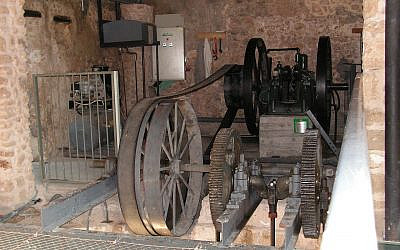
Restored mechanical water pump at Minkoff Citrus Orchards Museum, Rehovot. Courtesy Society for Preservation of Israel Heritage Sites (SPIHS)
In the yard and around the pool – which was also used as a swimming pool – Zalman Minkoff planted trees to give shade to area
In 1909, the author and journalist, Benjamin Gordon visited Eretz Israel to explore firsthand the economic possibilities of the land and its ability to absorb immigrants. Upon visiting Minkoff Orchard, Gordon admired the irrigation system, the impressive reservoir, the size of the orchard and the variety of trees. His impressions of Minkoff’s ability to “turn the desolate sand hills into the most beautiful plantation in the Land of Israel” are written in his book, the New Judah

Residents of early Rehovot posing next to the pool at Minkoff Orchards, 1913. Courtesy: Society for Preservation of Israel Heritage Sites
The pool is mentioned as a focal point in many stories about the early years of Rehovot, when children would head off there to cool off in the summer months, when young couples courted on its edges and families relaxed in the shade of the trees on their days of rest
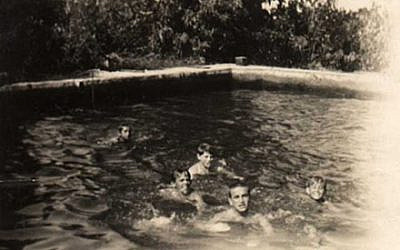
Children of early Rehovot enjoying the pool at Minkoff Orchards. Courtesy Society for Preservation of Israel Heritage Sites (SPIHS)
The orchard became a place of pride, not only for the residents of Rehovot, but also of the country and even Jewish tourists visiting from the Diaspora. Many flocked to examine how Minkoff got his trees to produce so much fruit that they were carried off on camel back to the port of Jaffa and exported to distant lands
Unfortunately, Zalman Minkoff didn’t live long enough to enjoy the fruits of his labor and dreams. In 1911, seven years after planting the orchards, he died at age 34. His wife gave birth to their second child on the very day he died, and called their daughter Zelma after her father. Broken-hearted, Rikva packed up her family and returned to her native Switzerland, not before selling the orchards
The orchard was earmarked for decades as a site of historical importance but little was done to preserve the buildings and infrastructure. The turning point came in 1994, when Francis Minkoff, a rich Jew from Geneva and a nephew of Zalman Minkoff, was taken to visit the run-down orchards by the late president of the Society for Preservation of Israel Heritage Sites (SPIHS), Shlomo Hillel. Overcome by emotion from discovering his family’s link to the place, Minkoff pledged a donation which covered the restoration of the site and the creation of a museum which tells the story of Israel’s agricultural history
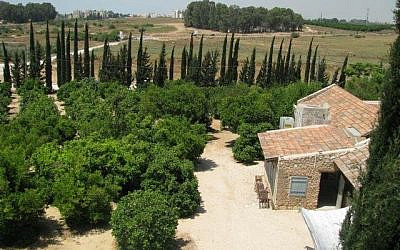
Aerial view of Minkoff orchards today. Courtesy Society for Preservation of Israel Heritage Sites
Today, Minkoff Citrus Orchard Museum in Rehovot is operated by SPIHS and is a popular heritage site among the 200 sites under the SPIHS umbrella. A packing house features a display that reconstructs the packing process in the early days of citrus growing, while visitors can also see the watering tunnels, the well and the reservoir. A highlight of the visit for all ages is a ride on a narrow-gauge train which meanders through the orchards. In season, visitors can pick oranges and prepare fresh juice
Remnants of the Minkoff Orchards pool today. Courtesy Society for Preservation of Israel Heritage Sites (SPIHS)
The museum is conveniently located near another famous heritage site, the Ayalon Institute Secret Bullet Factory, allowing visitors to make a full day of interesting family-friendly entertainment
There is no doubt that the vision of Zalman Minkoff and other pioneers in the Start Up Nation played a huge role in the birth of our country’s thriving agricultural arm, putting us on the map to become world leaders in water innovation
The Minkov Citrus Orchard Museum, Rehovot. Ph: 08-9469197. Email: pardes@shimur.org.il
Facebook: https://www.facebook.com/pardes.minkov.rehovot/
The Ayalon Institute Secret Bullet Factory, Rehovot. Ph: 08-9406552 , 052-5625747 (also WhatsApp). Email: noga@shimur.org.il
Meander through the orchards Courtesy https://www.facebook.com/pardes.minkov.rehovot/
חדשות ועדכונים אחרונים
עוגיות
אתר זה משתמש בעוגיות כדי לשפר את הפונקציונליות של האתר, לספק לך חוויית גלישה טובה יותר ולאפשר לשותפים שלנו לפרסם לך.
מידע המפרט על השימוש בעוגיות באתר זה וכיצד ניתן לדחות אותם, ניתן לצפות במדיניות העוגיות שלנו.
על ידי שימוש באתר זה או לחיצה על "אני מסכים", אתה מסכים לשימוש בעוגיות.

